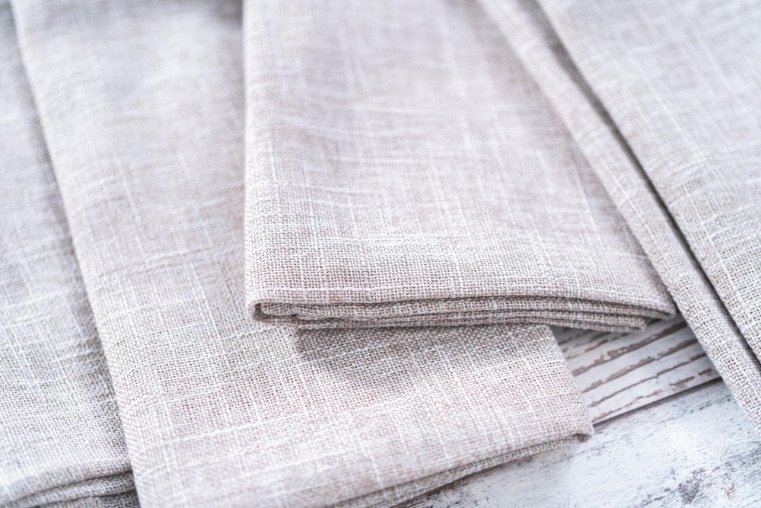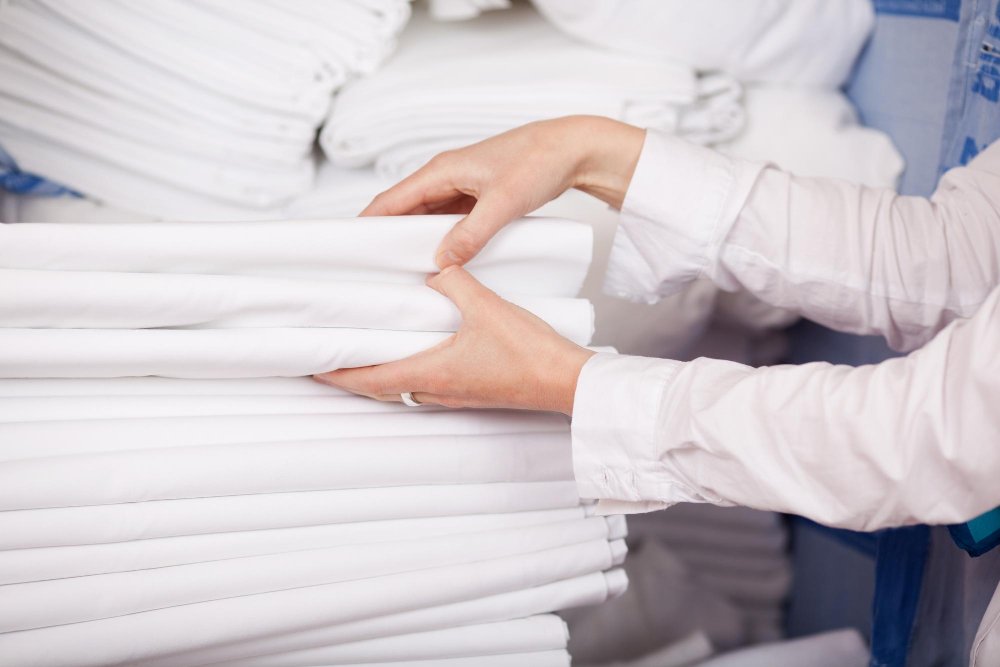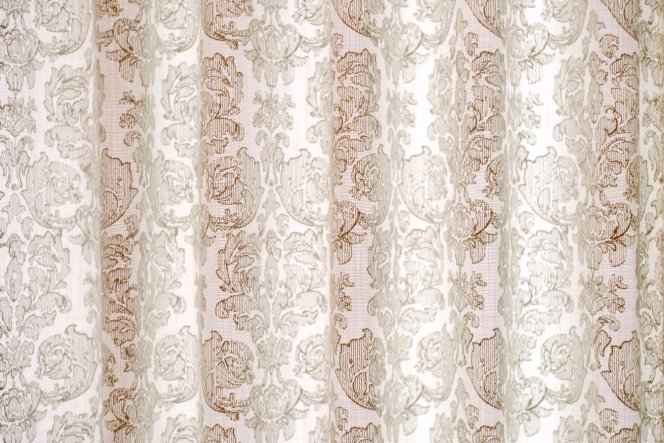Discover how this heavy-duty textile transforms from workwear to elegant home decor
Quick Summary
Butcher’s linen is a durable, heavyweight linen fabric originally used for butchers’ aprons. Today, it’s a designer favorite for table linens, curtains, and upholstery. You’ll love its natural texture, easy care, and the way it gets softer with every wash. Perfect for both traditional and modern homes, this fabric combines strength with style.
Table of Contents
What is Butcher’s Linen?
Butcher’s linen is a strong, heavyweight fabric with a plain weave structure and coarse yarns that give it a distinctive, textured appearance. Think of it as the workhorse of the linen family. While the name might sound industrial, this fabric has earned its place in high-end interior design.
True butcher’s linen is made from flax fibers, but you’ll also find modern versions that blend cotton or rayon to achieve a similar look and feel. According to Merriam-Webster, the fabric can refer to either the original linen weave or cotton and rayon blends finished to resemble linen.
The fabric typically weighs between 400-600 grams per square meter (about three times heavier than standard cotton poplin). This density gives it amazing durability while maintaining breathability.
Did You Know? The term “butcher linen” refers specifically to the heavyweight linen version, while “butcher cloth” describes rayon or cotton blends that mimic the linen look. The U.S. Federal Trade Commission requires this distinction to prevent misleading consumers.
History and Heritage
This fabric first gained popularity in 19th-century Europe, particularly France, where butchers and food workers needed protection from sharp tools and constant spills. The tightly woven structure created a barrier that was both tough and washable, making it perfect for demanding work environments.
Early versions were rough and stiff, prioritizing function over comfort. Workers appreciated how the plain weave allowed for quick drying and could withstand daily scrubbing without falling apart. By the 1920s, tailors noticed the fabric’s potential beyond workwear, adapting it for structured shirt fronts, collars, and eventually dress materials.
Today’s designers have transformed this humble workhorse into a sought-after textile for home decor. What was once valued purely for durability is now prized for its organic texture and the way it develops character over time.
Fabric Characteristics
Butcher’s linen has several unique features that set it apart from other fabrics:
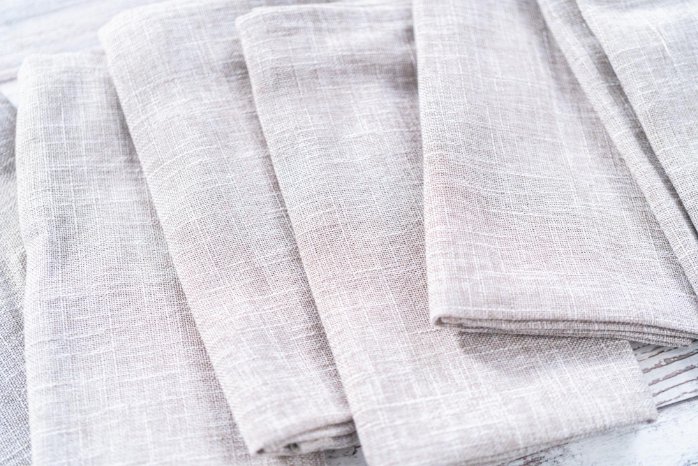
Texture and Appearance
- Visible slubs: These irregular bumps come from uneven yarn spinning and add natural character
- Matte finish: The surface gently diffuses light, avoiding the shine of sateen fabrics
- Natural color variations: Even in dyed versions, you’ll notice subtle tone differences that add depth
- Crisp drape: The fabric holds its shape well, creating clean folds and structured forms
Physical Properties
- Weight: Significantly heavier than typical voile or lawn fabrics
- Breathability: Natural fibers allow air circulation, preventing stuffiness
- Absorbency: Soaks up spills quickly (which is why butchers loved it)
- Durability: Resists tears and abrasion better than lighter linens
How It Ages
Unlike fabrics that deteriorate with use, butcher’s linen actually improves over time. The fibers soften with each wash while maintaining their structural integrity. This “lived-in luxury” quality is similar to what you’ll find in well-worn denim, where age adds appeal rather than diminishing it.
Sustainability and Environmental Impact
In today’s world, choosing eco-friendly fabrics matters more than ever. Butcher’s linen scores well on sustainability:
- Natural and biodegradable: Made from flax plants, the fabric breaks down naturally without leaving harmful residue
- Low water usage: Flax requires less water to grow compared to cotton
- Minimal pesticides: Flax is naturally pest-resistant, reducing the need for chemical treatments
- Long lifespan: One butcher’s linen item replaces multiple cheaper alternatives, reducing waste
- Fully utilizable plant: Every part of the flax plant can be used, from seeds (flaxseed oil) to fibers
- Carbon sequestration: Flax plants absorb CO2 while growing
When you choose butcher’s linen, you’re investing in a fabric that respects both tradition and the environment. The longevity of the material means fewer replacements over the years, which translates to less waste in landfills.
What is Butcher’s Linen Used For?
Modern applications for this fabric extend far beyond the butcher’s apron. Here’s where you’ll see it making an impact in homes and businesses today.
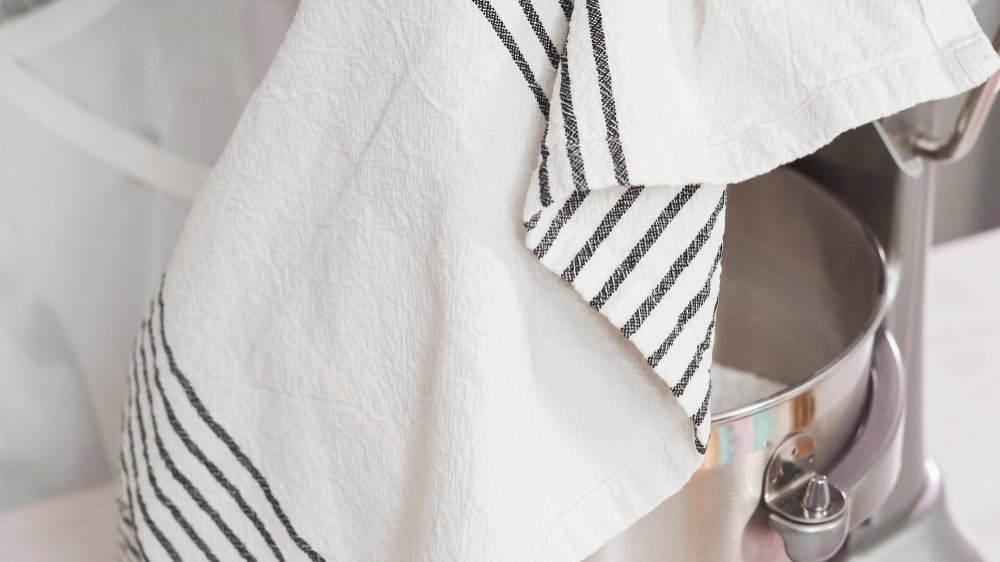
Table Settings and Dining
This is where butcher’s linen truly shines. The fabric’s practical origins make it perfect for dining applications:
Table Runners and Placemats
The heavyweight nature means your table runners stay put without sliding around. Natural stain resistance (thanks to the tight weave) helps hide minor spills, and the neutral tones work with any dishware. You can dress them up for formal dinners or keep things casual for everyday meals.
Napkins
Butcher’s linen napkins start crisp and structured but soften with use. They’re absorbent enough for messy meals yet elegant enough for special occasions. Unlike thin batiste napkins, these hold their shape throughout dinner service.
Tablecloths
For high-traffic dining areas (think restaurants or large families), you need something durable. Butcher’s linen tablecloths can handle daily use while maintaining their appearance. They’re also easier to care for than delicate damask linens.
Home Decor Applications
Window Treatments
The fabric’s weight creates beautiful, architectural folds in curtains and drapes. It filters natural light softly while providing privacy. Unlike sheer fabrics, butcher’s linen curtains won’t sag or lose their shape over time.
Upholstery
For furniture that gets regular use, this fabric offers practical luxury. It’s tough enough for dining chairs and sofas but softer than canvas. The natural texture adds warmth to rooms that might otherwise feel too polished.
Throw Pillows and Cushions
Butcher’s linen pillow covers develop a soft patina with handling. They pair beautifully with velvet, leather, or boucle for textural contrast. The fabric’s stiffness when new provides good structure, which softens into comfort over time.
Wall Hangings and Art
Designers are using raw-edged butcher’s linen as wall art, celebrating the fabric’s natural fraying and organic irregularities. This works especially well in modern farmhouse or minimalist interiors.
Kitchen Textiles
Beyond the dining table, consider butcher’s linen for tea towels, oven mitts (with proper lining), and aprons. Its original purpose makes it naturally suited for kitchen work.
Calculate Your Fabric Needs
Not sure how much fabric you need for your project? Try these helpful calculators:
- Linen Fabric Weight Calculator – Find the perfect GSM for your project
- Damask Yardage Calculator – Calculate fabric needed for any project
Quality and Durability
Not all butcher’s linen is created equal. Here’s what separates exceptional fabric from mediocre versions.
Construction Details
The best butcher’s linen features 60-80 threads per inch in a balanced plain weave. This density provides strength without making the fabric stiff or uncomfortable. Look for visible slubs that indicate natural, minimally processed fibers rather than overly refined yarns.
Quality fabric will have a thread density of 400-600 grams per square meter. Anything lighter might be labeled “butcher’s linen” but won’t deliver the same durability or drape.
Longevity Indicators
Here’s how to spot fabric that will last:
- Minimal pilling after 50+ washes: Quality linen fibers don’t form lint balls
- Stiff drape that softens gradually: Cheap versions start too soft and lose structure quickly
- Even dye penetration: Color should look consistent, not streaky
- Clean selvage edges: Finished edges indicate careful manufacturing
Test Your Linen Knowledge
Want to learn more about identifying quality linen? Take our Linen Quality Quiz to test your fabric knowledge in just 6 questions.
Real-World Performance
Some commercial kitchens still use butcher’s linen aprons from decades ago. This isn’t marketing hype – the fabric genuinely lasts when properly cared for. Home users can expect table linens to last 10-15 years with regular use, and upholstery to maintain its appearance for even longer.
Butcher’s Linen vs Other Fabrics
How does butcher’s linen stack up against other popular textiles? Here’s a practical comparison to help you decide if it’s right for your project.
| Feature | Butcher’s Linen | Standard Cotton | Polyester Blend | Pure Linen |
|---|---|---|---|---|
| Durability | Excellent (10-15 years) | Good (5-7 years) | Very Good (8-10 years) | Excellent (15+ years) |
| Shrinkage | Low (2-3%) | High (5-8%) | Minimal (1%) | Moderate (3-5%) |
| Texture | Coarse, visible slubs | Smooth, soft | Synthetic feel | Natural slubs, refined |
| Wrinkle Resistance | Low (wrinkles easily) | Moderate | High | Very Low |
| Breathability | Excellent | Good | Poor | Excellent |
| Price per Yard | $$ | $ | $ | $$$ |
| Best For | High-traffic dining, curtains | Everyday use, budget projects | Easy-care, wrinkle-free needs | Luxury bedding, special occasions |
| Care Difficulty | Easy | Very Easy | Very Easy | Moderate |
Butcher’s Linen vs Standard Linen
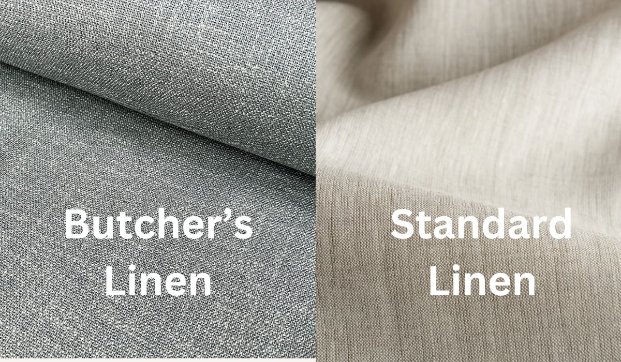
The main difference is weight and texture. Standard loose weave linen is lighter and more refined, perfect for clothing and bedding. Butcher’s linen is heavier and coarser, making it ideal for applications requiring durability. Think of standard linen as a silk blouse and butcher’s linen as a sturdy work jacket.
Butcher’s Linen vs Cotton
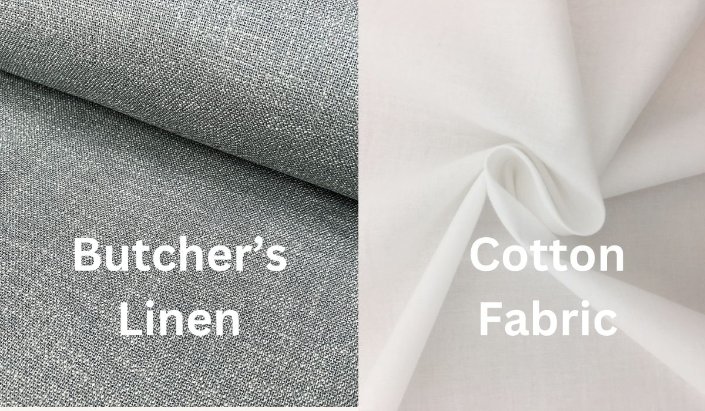
Cotton (like broadcloth) is softer from the start and more affordable, but it doesn’t last as long. It also shows stains more readily and can develop a worn appearance faster than butcher’s linen. For items you’ll use daily for years, butcher’s linen offers better value despite the higher initial cost.
Butcher’s Linen vs Polyester Blends
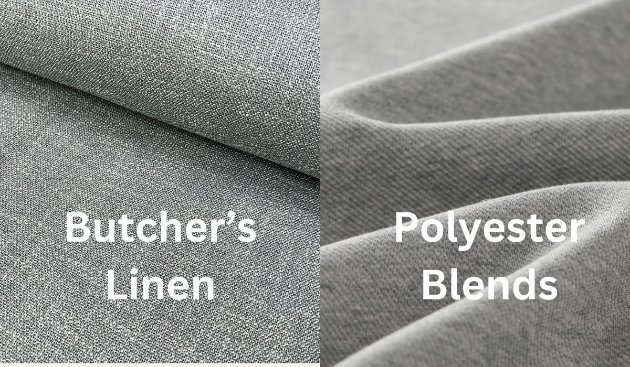
While polyester resists wrinkles and requires less care, it lacks the natural breathability and texture of butcher’s linen. Polyester also doesn’t improve with age – it starts soft and stays the same, whereas butcher’s linen develops character. For authentic, natural aesthetics, butcher’s linen wins.
Styling Ideas: Shop the Look
Here are some design-approved ways to incorporate butcher’s linen into your space.
Rustic Farmhouse Dining
Pair natural-toned butcher’s linen table runners with reclaimed wood tables, vintage brass candlesticks, and stoneware dishes. Add jersey-knit chair cushions for comfort. The texture contrast between rough linen and smooth ceramics creates visual interest.
Modern Minimalist
Use butcher’s linen in neutral grays or soft whites for a clean, streamlined look. Combine with glass tables, steel chair frames, and simple geometric dishware. The fabric’s organic irregularities soften the hard edges of modern furniture.
Coastal Casual
Choose butcher’s linen in soft blues, sandy beiges, or crisp whites. Mix with weathered wood, rope accents, and natural satin finishes. The fabric’s relaxed drape suits coastal aesthetics perfectly.
Layered Textures
Create depth by combining butcher’s linen with contrasting fabrics:
- Pair linen table runners with chiffon overlays for special events
- Mix linen curtains with velvet throw pillows
- Layer linen placemats over broderie anglaise tablecloths
Color Combinations That Work
Butcher’s linen comes in various colors, but these combinations always look good:
- Neutrals: Oat, sand, taupe, greige
- Earth tones: Terracotta, olive, rust, ochre
- Cool blues: Slate, powder blue, navy
- Classic: Crisp white, charcoal gray, warm ivory
Complete Care Guide
Proper care keeps your butcher’s linen looking great for years. The good news? This fabric is easier to maintain than you might think.
Watch: Professional tips for washing, drying, and maintaining linen fabrics
Washing Instructions
Follow these steps for best results:
Temperature
Wash in cold to lukewarm water (30-40°C or 86-104°F) for regular cleaning. You can use warmer water (up to 60°C or 140°F) for heavily soiled items, but avoid making this your standard practice as it can cause gradual shrinkage.
Detergent Choice
Use mild, neutral detergents without bleach or optical brighteners. These chemicals can weaken natural fibers over time. Add detergent to water first, then add linens – never pour detergent directly on the fabric.
Machine Settings
Choose a gentle cycle with a low to medium spin speed. Don’t overload your machine – linens need room to move freely, which reduces wrinkling and prevents damage from friction.
Hand Washing
For delicate items or heirloom pieces, hand wash using a gentle swishing motion. Never wring, twist, or scrub aggressively. Rinse thoroughly until water runs clear.
Personalized Care Instructions
Need specific care advice for your linen? Use our Linen Care Calculator to get personalized washing and maintenance instructions based on your fabric type.
Drying Methods
How you dry butcher’s linen affects its longevity and appearance:
Air Drying (Recommended)
Hang or lay flat to dry naturally. This method prevents shrinkage and preserves fiber strength. For white linens, drying in sunlight helps maintain brightness. Colored linens should dry in shade to prevent fading.
Machine Drying
If you must use a dryer, choose low heat and remove items while still slightly damp. Overdrying weakens fibers and increases shrinkage. It also makes ironing more difficult.
Ironing Tips
Butcher’s linen wrinkles naturally – it’s part of its charm. But if you prefer crisp linens:
- Iron while fabric is still damp for best results
- Use medium to high heat with steam
- Iron on the reverse side to prevent shine
- For a lived-in look, skip ironing and embrace the wrinkles
Stain Removal Guide
Act quickly on stains for best results. Here’s your quick reference:
| Stain Type | Treatment Method | Time-Sensitive? | Success Rate |
|---|---|---|---|
| Red Wine | Blot immediately, apply baking soda paste, rinse with cold water | Yes – treat within 5 minutes | High if quick |
| Oil/Grease | Sprinkle cornstarch to absorb, let sit 15 minutes, brush off, apply dish soap | Within 30 minutes | Very High |
| Coffee | Rinse with cold water, apply white vinegar solution (1:2 ratio) | Within 1 hour | High |
| Tomato Sauce | Scrape off excess, apply lemon juice, expose to sunlight | Can wait several hours | Moderate |
| Wax/Candle | Freeze to harden, scrape off, iron between paper towels | No rush | Very High |
| Ink | Dab with rubbing alcohol, blot with clean cloth | As soon as possible | Moderate |
Pro Tip: Always test stain treatments on a hidden area first. Some methods work differently depending on dye types and fabric treatments.
Storage Tips
Proper storage prevents damage during off-seasons:
- Clean items thoroughly before storing
- Store in breathable cotton bags, never plastic
- Avoid tight folding – roll items when possible
- Add cedar blocks or lavender sachets to deter moths
- Store in cool, dry places away from direct sunlight
- Rotate stored items seasonally to prevent permanent creases
Common Care Mistakes to Avoid
- Using bleach: Weakens fibers and changes fabric color
- Overloading the washer: Causes excessive wrinkling and poor cleaning
- High heat drying: Leads to shrinkage and fiber damage
- Storing damp: Creates mildew and musty odors
- Wringing wet fabric: Stretches and distorts shape
What Customers Say
Real experiences from people using butcher’s linen in their homes:
“I bought these table runners for my dining room three years ago, and they still look amazing. They’ve been through countless dinners, holiday gatherings, and kid spills. The fabric has softened beautifully but hasn’t lost any of its structure. Worth every penny.”
“As a restaurant owner, I needed something that could handle daily use and frequent washing. Butcher’s linen napkins have been perfect. They maintain their appearance even after hundreds of washes, and guests often compliment them.”
“Love the texture and durability, but be prepared for wrinkles. I’ve learned to embrace the relaxed look rather than fighting it with an iron. The natural, lived-in appearance actually suits my farmhouse style perfectly.”
“I made curtains from butcher’s linen for my living room. The weight creates beautiful folds, and they filter light without making the room dark. Two years later, they still hang perfectly without any sagging.”
“Initially, I was worried about the stiff texture, but it softened after a few washes. Now my placemats have this perfect mix of structure and softness. They’re thick enough to protect the table but comfortable enough for daily use.”
Customer Showcase: Real Homes, Real Style
See how people are using butcher’s linen in their homes. These photos show the fabric’s versatility across different design styles.
📸 Customer Photo Gallery
Customers have shared beautiful photos of butcher’s linen in their dining rooms, kitchens, and living spaces – from modern farmhouse tables with natural runners to elegant coastal settings with soft blue linens. The fabric’s texture adds warmth to every style.
Share your own butcher’s linen photos with us and you might be featured!
Love Your Purchase? Share a photo of your butcher’s linen in action! Tag us on social media or send us a picture – we love seeing how you style these pieces in your home.
Product Features and Pricing
Why Buy Butcher’s Linen with Confidence
✓
Quality Guaranteed
Premium construction standards
📦
Free Shipping
On orders over $2500
↩
Easy Returns
30-day return policy
⭐
1000+ Reviews
4.8 average rating
Understanding pricing helps you get the best value for your investment.
What Affects Price
Several factors determine butcher’s linen costs:
- Fiber content: Pure linen costs more than cotton or rayon blends
- Thread count: Higher density (80+ threads per inch) increases price
- Width: Standard 140cm widths are most economical
- Dyeing method: Natural dyes and custom colors add cost
- Finishing: Hemmed edges, pre-washing, and special treatments affect price
Typical Price Ranges
| Product Category | Regular Price Range | Average Sale Discount | Best Purchase Timing |
|---|---|---|---|
| Table Runners (6-8 ft) | $45-$85 | 22% off | January, July |
| Curtain Panels (pair) | $90-$160 | 18% off | March, November |
| Upholstery Fabric (per yard) | $28-$35 | 30% off | September |
| Napkins (set of 4) | $35-$55 | 20% off | January, June |
| Tablecloths (60×90″) | $75-$140 | 25% off | Post-holiday sales |
Bulk Purchase Benefits
If you’re buying for a large project or business:
- Orders over $500: $9.99 shipping (3-5 day delivery)
- Orders over $2500: Free expedited shipping (2-4 day delivery)
- First-time buyers: Extra 10% discount (combine with sales)
- Commercial accounts: Custom quotes available
Value Considerations
While butcher’s linen costs more upfront than cotton or polyester, consider the long-term value:
- Lasts 2-3 times longer than standard fabrics
- Maintains appearance with minimal care
- Improves with age rather than deteriorating
- Lower replacement frequency saves money over time
Frequently Asked Questions
Butcher’s linen offers better breathability and texture due to its tightly woven natural fibers. It resists pilling and softens over time, making it better for frequent use in dining or decor settings. While cotton is softer initially and more affordable, butcher’s linen lasts significantly longer and develops character with age.
Yes, absolutely. The durable weave holds up well to regular laundering – this is exactly what it was designed for. For best longevity, use cold water and air-drying. The fabric actually improves with washing, becoming softer while maintaining its structural integrity.
Butcher’s linen has natural stain resistance thanks to its tight weave, and spills tend to bead up rather than immediately soaking in. The fabric’s crisp drape creates polished table settings, while its durability handles daily use. It works equally well for formal dinners and casual meals.
Iron the fabric while it’s still slightly damp using medium to high heat with steam. For best results, iron on the reverse side. However, many people embrace the natural wrinkles as part of the fabric’s relaxed charm. You can also hang items in a steamy bathroom to release minor wrinkles.
Definitely. Designers frequently use butcher’s linen for curtains, pillow covers, upholstery accents, and even wall hangings. Its versatility extends to crafting aprons, tote bags, or any project requiring durable, textured fabric.
Expect 2-3% shrinkage, which is minimal compared to regular cotton (5-8%). Using cold water and air-drying minimizes shrinkage. Many manufacturers pre-wash fabric to reduce this issue. If you’re sewing with butcher’s linen, pre-wash before cutting to account for any shrinkage.
Damask linen features decorative woven patterns and is typically more delicate, while butcher’s linen has a simple plain weave and is more durable. Damask suits formal occasions, while butcher’s linen works for everyday use. Both are quality options, but serve different purposes.
Yes, it’s actually ideal for commercial settings. The fabric was originally designed for demanding work environments, so it handles high-frequency washing and heavy use. Many restaurants prefer it for table linens and napkins because it maintains appearance despite daily service.
Final Thoughts
Butcher’s linen represents a rare combination of practical durability and natural beauty. What started as workwear fabric in 19th-century butcher shops has evolved into a design staple for modern homes and restaurants. Its heavyweight construction, distinctive texture, and remarkable longevity make it stand apart from lighter cambric or holland linen fabrics.
The fabric improves with use, developing a soft patina while maintaining its structural integrity. This “lived-in luxury” quality appeals to people seeking authentic materials that tell a story. Unlike synthetic alternatives that start strong but degrade over time, butcher’s linen begins its life sturdy and only gets better.
For dining applications – table runners, napkins, tablecloths – butcher’s linen offers practical elegance. The tight weave naturally resists stains, while the weight keeps linens in place during meals. In home decor, it brings organic warmth to curtains, upholstery, and accent pieces without feeling precious or overly delicate.
Care is straightforward: cold water washing, air drying, and optional ironing. The fabric tolerates regular use and frequent cleaning, making it suitable for both special occasions and everyday life. While the initial cost exceeds that of cotton or polyester, the longevity provides better value over time.
Key Takeaways
- Durability wins: Butcher’s linen outlasts most fabrics, making the higher price worthwhile for items you’ll use regularly
- Embrace the texture: The natural slubs and wrinkles are features, not flaws – they add character and authenticity
- Start simple: Begin with table runners or napkins to test the fabric before investing in larger projects
- Care is easier than expected: Despite its upscale appearance, maintenance requires only basic washing and occasional ironing
- Mix and match: Butcher’s linen pairs beautifully with other textiles – experiment with layering different textures
- Consider pre-washing: If sewing projects, wash fabric first to account for slight shrinkage
- Quality varies: Look for 60-80 threads per inch and visible slubs to identify authentic, durable fabric
Making Your Decision
Choose butcher’s linen if you want:
- Long-lasting table linens that improve with age
- Natural texture and organic aesthetics
- Durable upholstery for high-traffic furniture
- Low-maintenance fabrics despite upscale appearance
- Sustainable, natural fiber options
Consider alternatives if you need:
- Wrinkle-free fabrics (try polyester blends)
- Ultra-soft textiles from day one (try brushed cotton)
- Budget-friendly options (try standard calico cotton)
- Delicate, formal appearance (try lace or Chantilly)
Where to Start
If you’re new to butcher’s linen, we recommend starting with a table runner or set of napkins. These smaller items let you experience the fabric’s texture and care requirements without a major investment. You’ll quickly see how the material performs with regular use and washing.
For larger projects like curtains or upholstery, request fabric samples first. Seeing and feeling the material in person helps you understand its weight, texture, and how it complements your existing decor. Many suppliers offer sample swatches for a minimal cost.
Take advantage of seasonal sales (typically January, July, and September) to get quality fabric at better prices. For commercial applications or large projects, ask about bulk discounts and custom quotes.
Most importantly, remember that butcher’s linen is forgiving. It doesn’t demand perfection – minor wrinkles, natural variations, and the soft patina that develops over time are all part of its appeal. This is a fabric that lets you live comfortably while maintaining style.
Learn More: For additional information about linen fabrics and textile care, visit these trusted resources:

